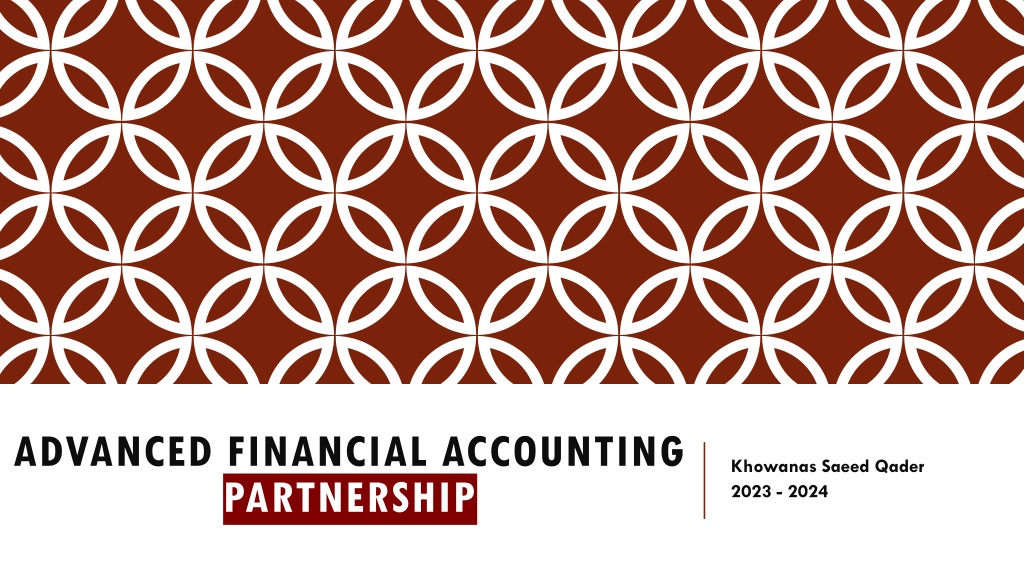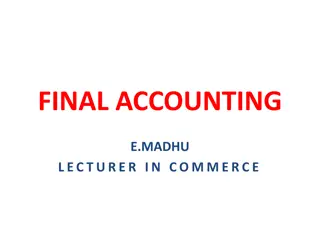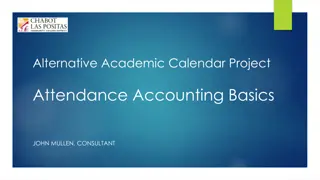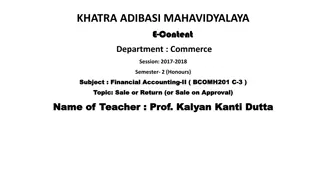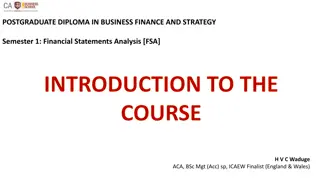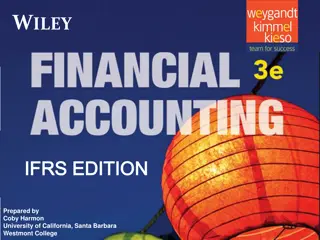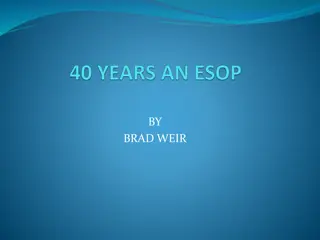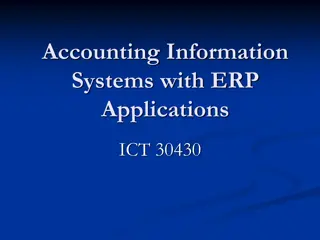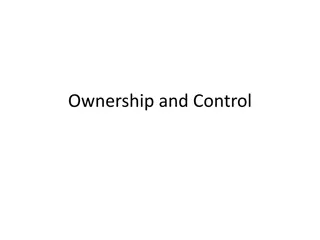Understanding Ownership Structures in Advanced Financial Accounting
Explore the various types of ownership structures in advanced financial accounting, including Sole Proprietorship, Partnership, and Corporation. Learn about the characteristics, risks, and advantages of each structure, as well as the essential elements of a partnership agreement. Gain insights into the classification of businesses and the importance of clear agreements for successful partnerships.
- Financial Accounting
- Ownership Structures
- Partnership Agreement
- Business Classification
- Accounting Principles
Download Presentation

Please find below an Image/Link to download the presentation.
The content on the website is provided AS IS for your information and personal use only. It may not be sold, licensed, or shared on other websites without obtaining consent from the author. Download presentation by click this link. If you encounter any issues during the download, it is possible that the publisher has removed the file from their server.
E N D
Presentation Transcript
ADVANCED FINANCIAL ACCOUNTING PARTNERSHIP Khowanas Saeed Qader 2023 - 2024
CHAPTER - ONE INTRODUCTION TO ADVANCED FINANCIAL ACCOUNTING 1-Types of Ownership Structure A-Sole Proprietor Ship B-Partnership C-Corporation 2-Types of Companies A-Personal Firms B-Fund Companies
1-TYPES OF OWNERSHIP STRUCTURE There are three types of ownership they are: A-Sole Proprietor Ship B-Partnership C-Corporation
A-Sole Proprietor Ship: In this kind of ownership, the company is owned by one person only. The owner called a proprietor will often manage the business. The proprietor assume all risks of the business and the owners personal assets can be taken to pay the creditor. B-Partnership: In this kind of ownership the company is owned by more than one person, one or both partners manage the business. And there assets ((personal assets)) can be taken to pay the creditors, the owners of the partnership share the risks of there decision. C-Corporation: In this kind of ownership the stockholder owners the company, and there are many owners of the company. The owners have limited risk to their investment; in another hand they have little influence on the business decision.
2- Types of Business (Firm) : In general, firms classified into two main types they are : A - Informal firm 1. Sole proprietorship 2. Partnership B - Formal firm 1. corporation 2. Limited responsibility
CHAPTER-TWO ACCOUNTING FOR PARTNERSHIP 1-Partnership definition: Partnership is defined as "an association of two or more persons to carry on a business as co-owners for profit. 2-Partnership agreement: Good business practice demands that the partnership agreement be clearly stanned in writing. among the more important points to be covered by the partnership agreement are:-
2-Partnership agreement: 1- The date of formation of the partnership 2- The name of the partners and the nature of the partnership 3- The capital to be invested by each partner. 4- The authority to be vested in each partner and the rights and duties of each 5- The accounting period to be used. 6- The plan for sharing profits and losses. 7- The salaries and drawings allowed to partners. 8- Insurance on the lives of partners. 9- Provision for the arbitration of disputes and liquidation of partnership at the end of the contract or at the death or withdrawal of a partner.
3-CHARACTERISTICS OF PARTNERSHIP: THE BASIC CHARACTERISTIC OF PARTNERSHIP IS BRIEFLY SUMMARIZED BELOW: A-Ease Of Formation: In contract to the corporation a partner may be created by an oral or writing contract between two or more persons or may be implied by their contract. B-Mutual Agency: Each partner has the authority to act for the partnership and to enter into contracts binding upon it.
C-Limited Life: A partnership may be ended by death, retirement, or bankruptcy. Or incapacity of a partner, the admission of a new member to the partnership legally ends the former partnership and establishes a new one. D-Unlimited Liability: All the partners are personally responsible for the debts of the firm and all have authority to act for the firm, each partner is personally responsible for the liabilities of the firm. E-Co-Ownership of Partnership in: Property, earnings, when a partner invests assets in partnership it becomes joint property of all the partners and every partner has an ownership interest in earnings.
4-ACCOUNTING FOR INITIAL INVESTMENTS: THE INITIAL INVESTMENT OF THE PARTNER IN PARTNERSHIP MAY TAKE THE FOLLOWING FORMS:- A. cash investment. B. cash and other assets investment. C. investment of assets and liability. D. joining two sole proprietaries to make a partnership. E. intangible contribution. For example (experience)
A-CASH INVESTMENT: THE PARTNERS MAY PAY THEIR RATE IN PARTNERSHIP CAPITAL IN CASH AS SHOWN BELOW: Example 1: On 2nd September 2020, Zakariya and Mohammed agreed to go into business as partners, According to the agreement, Zakariya is to pay $35000 cash and Mohammed is to contribute $25000 cash. Require: Prepare the journal entry on 2nd September 2020.
Example : On 1st October 2021, Kurdistan and Rawan agreed to go into business as partners, According to the agreement, Kurdistan is to pay $135000 cash and Rawan is to contribute $225000 cash. Require: Prepare the journal entry on 1st October 2021.
B-CASH AND OTHER ASSETS INVESTMENT:- Partners May Invest Cash And Other Assets To Make Partner Ship. In This Case We Must Revalue The Assets In Fair Market Value At The Date Of Formation Of Partnership. Example 2: Dana And Ahmed Joined Together To Make Partnership On {1st, 2, 2020} Dara Invested $200000 In Cash And Ahmed Paid $100000 In Cash and Ahmed contributes these assets The Following Assets: 1. Inventory Valued At $54000 2. Office Equipment Valued At $46000 3. Land Valued At $70000 Require: Prepare Opening Entry In {1st .2 .2020}?
Example 2: Dana And Ahmed Joined Together To Make Partnership On {2nd, 5, 2019} Dara Invested $150000 In Cash And The Following Assets: 1. Inventory Valued At $23000 2. Office Equipment Valued At $27000 3. Land Valued At $55000 Ahmed Paid $80000 In Cash And The Following Assets: 1. Inventory Valued At $33000 2. Office Equipment Valued At $26000 3. Land Valued At $45000 4- Account receivable Value at $27000 Require: Prepare Opening Entry In {2nd, 5, 2019}?
C-INVESTMENT OF ASSETS AND LIABILITIES: IN A NEW PARTNERSHIP THE PARTNERS MAY MAKE THEIR INVESTMENT IN ASSETS AND LIABILITIES AS SHOWN IN THE FOLLOWING EXAMPLE: Example 3: On 1st October 2020, Mohammed and Omer formed a partnership for selling computers; they invested in the business as shown in the following: A . Mohammed s contribution (investment) * cash 20000 $, inventory 100000 $ accounts payable (A\P) 50000 $ * Account receivable (A\R) 40000 $ less allowance for doubt full accounting 10000$ Computer equipment coasted 100000 $, market value 90000 $ B. Omer s contribution: * cash 300000 $ Computers coasted 360000 $, market value 200000 $ Require: prepare the opening entry and post the entry to the ledger.
Example 3: In 1st October 2021, Mohammed and Omer formed a partnership for selling computers; they invested in the business as shown in the following: A . Mohammed s contribution (investment) * cash 25000 $, inventory 110000 $ accounts payable (A\P) 55000 $ * Account receivable (A\R) 45000 $ less allowance for doubt full accounting 15000$ Computer equipment coasted 110000 $, market value 100000 $ B. Omer s contribution: * cash 300000 $ inventory 115000 $ accounts payable (A\P) 60000 $ * Account receivable (A\R) 50000 $ Computers coasted 360000 $, market value 200000 $ Require: prepare the opening entry and post the entry to the ledger.
D-Joining Two Sole Proprietary to Make Partnership: Two or more sole proprietor may combine their business to form a partnership. Their balance sheet serves the basis for opening entries for investment of eachpartner. NOTE: The allowance for accumulated depreciation in sole proprietor balance sheet not inters to the opening entry of a new partnership the assets maybe revolution in fair market value. Example 4: On July 1, 2018 Beston and Barham combined their two businesses to form partnership under the firm name of { Beston and Barham Co.} the balance sheets of the two sole proprietary ships are shown below:
Beston Company Balance sheet June 30 . 2018 Assets Liabilities Cash 460000 A/R 420000 Less allowance for doubt full (48000) 372000 Inventory 2858000 Store equipment 926000 Less accumulated depreciation (240000) 686000 Total 4376000 A/P 769000 N/P 360000 Beston capital 3247000 Total 4376000 Barham Company Balance sheet June 30 . 2018 Assets Liabilities Cash 335000 A/R 415000 Less allowance for doubt full (25000) 390000 Merchandise Inventory 2724000 Supplies 926000 Office equipment 883000 Less accumulated depreciation (340000) 543000 Story equipment 917500 Less: accumulated depreciation (425000) 492500 A/P 550000 N/P 600000 Barham capital 3247000 Total 4569000 Total 4569000
The balance sheets reflect fair market value except for the following terms: A: the fair market value of Beston s store equipment is 735000 $ B: the fair market value of Barham s office equipment and store equipment are 587500 $ and 610000 $ respectively. Require : Prepare the opening entry for the formation of partnership as of July 1.2018 And posting the entry to the ledger?
Solution: Journal Entry Barham (capital) N 1 2 3 4 5 6 7 8 9 10 Date Account Name Debit 335000 415000 2724000 926000 587500 610000 Credit July 1, 2018 July 1, 2018 July 1, 2018 July 1, 2018 July 1, 2018 July 1, 2018 July 1, 2018 July 1, 2018 July 1, 2018 July 1, 2018 Cash Account receivable Inventory Supplies Office equipment Store equipment Less allowance for doubt full accounting Account Payable Notes Payable Barham (capital) 25000 550000 600000 4422500
Cash Account A/R Account Inventory Account Supplies Account Dr CR Dr CR Dr CR Dr CR 1 1 1 1 460,000 2 335000 795000 420,000 2 415,000 835000 2,858,000 2 2,724,000 5,582,000 926000 795000 835000 5,582,000 926000 926000 Office equipment Account Dr 1 587,500 Store equipment Account Dr 1 735,000 2 610000 1345000 Allowance for Doubt Account Dr A/P Account Dr CR CR CR 1 CR 1 48000 2 25000 769000 2 550000 1319000 587500 587500 1345000 73,000 73,000 1319000 N/p Account Beston Capital Account Dr Barham Capital Account Dr Dr CR CR CR 1 1 1 360,000 2 600000 960,000 3,296,000 4422500 960,000 3,296,000 3,296,000 4422500 4422500
Example 5 : On July 1, 2019, Ahmed and Mohammed combined their business to form a partnership under the firm name of {Ahmed and Mohammed Co.} The two balance sheet of them are as follow : Ahmed Company Balance sheet June 30 . 2019 Assets Liabilities Cash 4520 A/R 3275 Less allowance for doubt full (475) 2800 Merchandise Inventory 28190 Supplies 960 Office equipment 7400 Less accumulated depreciation (1800) 5600 Story equipment 7700 Less: accumulated depreciation (1500) 6200 Total 48270 A/P 6300 N/P 8000 Ahmed capital 33970 Total 48270
Mohammed Company Balance sheet June 30 . 2019 Assets Liabilities Cash 7100 A/R 4500 Less allowance for doubt full (620) 3880 Inventory 21430 Store equipment 8200 Less accumulated depreciation (1300) 6900 Total 39310 A/P 8400 N/P 2500 Mohammed capital 28410 Total 39310 The balance sheets reflect fair market value except for the following terms: A: the fair market value of Mohammed store equipment is 7500 $ B: the fair market value of Ahmed office equipment and store equipment are 6100$ and 6800 $ respectively. Require : Prepare the opening entry for the formation of partnership on July 1.2019
N Date Account name Debit Credit
M&A Company Balance sheet June 30 . 2023 Assets Liabilities Cash 17000 A/R 3900 Less allowance for doubt full (900) 20000 Inventory 20000 Store equipment 10000 Plant 20000 Supplies 3000 Less accumulated depreciation (3000) 70000 Total 70000 A/P 34000 N/P 6000 capital 30000 Total 70000 The balance sheets reflect fair market value does not except for the following terms: A: the fair market value of Plant is 17500 $ B: the fair market value of office equipment and store equipment are 6100$ and 6800 $ respectively. Require : 1-Prepare the opening entry for the formation of partnership on Dec 31.2023 2-posting the entry to the ledger
N Date Account name Debit Credit
E Intangible contributions: In forming a partnership the contributions made by one or more of the partner may go beyond assets and liabilities, accounting for such special contribution may be appropriately included as a provision of any partnership agreement: Example A: Assume that Sardar and Ali plan to open an advertising agency and decide to organize a partnership, Sardar contributes cash of 140000 $ and Ali invested only 20000 $, however, is an accomplished graphic artist with a skill that is considered especially valuable to this business, for this reason, the partners agree to start the business in equal capital balance. Require: In recording this agreement Sardar and Ali have two options available: 1- the bonus method 2- the goodwill method
SOLUTION When Sardar and Ali decide to organize a partnership and start an advertising agency, they have two options for recording the agreement: the bonus method and the goodwill method. Let's explore how each method would be recorded in this scenario. 1. Bonus Method: In the bonus method, the partner with the special skill (Ali, in this case) is given a bonus in the form of additional capital to bring the capital accounts into equal balance. The bonus is based on the value of the skill brought into the partnership. Assuming they decide on a bonus amount for Ali's graphic art skills, the journal entry would look like this: Sardar s capital $140,000 Ali s Capital Account $20,000 To Cash Account: $160,000 (Assuming the agreed bonus amount for Ali's skill) Explanation: Sardar contributes $140,000 in cash, Ali contributes $20,000 in cash, and a bonus of $60,000 is credited to Ali's capital account to reflect the value of his graphic art skills. This brings both partners' capital accounts into equal balance.
GOODWILL METHOD In the goodwill method, the value of the special skill is recorded as goodwill on the books. Goodwill represents the value of intangible assets such as skills, reputation, etc. Sardar's Capital Account: $140,000 Ali's Capital Account: $20,000 To Goodwill Account: $120,000 (Assuming the agreed goodwill amount for Ali's skill) Explanation: Sardar contributes $140,000 in cash, Ali contributes $20,000 in cash, and the value of Ali's graphic art skill is recorded as goodwill in the books. This brings both partners' capital accounts into equal balance. It's important to note that the actual bonus or goodwill amount may vary based on negotiations between the partners and the agreed-upon value of Ali's skill to the business. Additionally, consulting with a professional accountant is recommended to ensure compliance with accounting standards and regulations.
Example B: Assume Alan and Jayce have contributed a total of 160000 $ to their a new partnership, Alan paid $ 90000 in cash; Jayce paid his capital in assets as follows: Inventory 30000 $, land valued 40000 $ because of special skill of Jayce the partner agree to start the business in equal . capital balances. Require: Prepare beginning entry for the formation of new partnership in: A- bonus method B-goodwill method
5- Sharing profit and losses: Partnership revenues and expenses are closed out at the end of each fiscal period, reclassifying net income or loss to partner's capital accounts. Each partner maintains a separate equity balance, and state partnership law typically requires equal share in profits or losses. The many possible arrangements for sharing of net income or loss among partners may be summarized in to the following classes:- 1- dividing profit and loss equally 2- dividing profit and loss in some other agreed ratio 3- dividing profit and loss in the ratio of partners capitals 4- allowing salaries to partners and dividing the remaining profit and loss in an agreed ratio 5. Allowing salaries to partners, allowing interest on capitals, and dividing the remaining profit and loss in an agreed ratio.
1- dividing profit and loss equally: Example: Assume that Mohammed and Khoshnaw form a partnership by investing cash of 200000 and $, 160000 $ respectively. At the end of the first year of operation, the partnership reported a net income of 120000 $ and a partnership agreement basis in equal sharing of profit and loss. Require: 1-prepare entry for the partner s initial investment 2-prepare entry for sharing profit and loss equally 3-prepare statement of partners capital
1- dividing profit and loss equally: Example: Assume that Dilan and Miran form a partnership by investing cash of 500000 and $, 260000 $ respectively. At the end of the first year of operation, the partnership reported a net income of 1350000 $ and a partnership agreement basis in equal sharing of profit and loss. Require: 1-prepare entry for the partner s initial investment 2-prepare entry for sharing profit and loss equally 3-prepare statement of partners capital
2 - division ((sharing)) profit and loss in some other agreement ratio: Example: Tn this illustration we shall assume that Mohammed and Khoshnaw agree to share profitand loss in the ratio of 40% for Mohammed and 60% for Khoshnaw. Require: 1-prepare entry for sharing profit and loss 2-prepare statement of partners capital
2 - division ((sharing)) profit and loss in some other agreement ratio: Example: Tn this illustration we shall assume that Dilan and Miran agree to share profitand loss in the ratio of 45% for Dilan and 55% for Miran. Require: 1-prepare entry for sharing profit and loss 2-prepare statement of partners capital
3- Division of profit and loss on the ratio of partner's capital. Example: Assume that Khoshnaw , Mohammed, and Omer are partners and their capital balance at The end of the year is shown in the following, And also assume that the partners At the end of the year earned net loss of 60000 $. Khoshnaw capital 80000 Mohammed capital 120000 Omer capital 100000 Total 300000 Require: 1- Allocate the net loss on the bases of the partner's capital and prepare theentries 2- Prepare statement of partner's capital.
3- Division of profit and loss on the ratio of partner's capital. Example: Assume that Dilan , Zagroz, and Ali are partners and their capital balance at The end of the year is shown in the following, And also assume that the partners At the end of the year earned net loss of 100,000 $. Dilan capital 160,000 Zagroz capital 150,000 Ali capital 190,000 Total 500,000 Require: 1- Allocate the net loss on the bases of the partner's capital and prepare theentries 2- Prepare statement of partner's capital.
4. Allowing salaries to the partner's and dividing the remaining profit and loss in an agreed ratio: Example: Dalen, Azad, and Avan formed the partnership, and assume that thepartnership agreement provides for an annual salary of 20000 $, 8000 $, 12000 $,respectively, and the remaining net income divided on the bases of 2:2:1 respectivelyand the beginning capital balance is 200000, 100000, 400000 assume that netincome of this year was 140000 $. Require: prepare the necessary entries for paying salaries and dividing net income.
Example: Arez, Jihanger, and suhaib formed the partnership, and assume that thepartnership agreement provides for an annual salary of 160000 $, 180000 $, 170000 $,respectively, and the remaining net income divided on the bases of 3:2:4 respectivelyand the beginning capital balance is 900000, 800000, 700000 assume that netincome of this year was 990000 $. Require: prepare the necessary entries for paying salaries and dividing net income and prepare the capital statement as well.
5- Allowing salaries to the partners and interest on their capitals and dividing the remaining profit and loss in an agreed ratio. Example: By retaining to above example and assuming the same information in addition to the partner s agreement to give interest at the ratio of 10 % on the partner s capital balance on the date of forming the partnership, and we assume that this capital balance was as the following: Dallin s capital balance of 200000 $ Azad's capital balance of 100000 $ Avan's capital balance of 400000 $ Requirement: prepare the necessary entries for paying salaries and interest on the beginning capital balance and dividing the remaining profit at the ratio of 2:2:1 respectively and prepare the capital statement?
Example: Assume that Mohammed and Omer form a partnership on January 1.2020 Mohammed invested 100000 and will draw a salary of 70000 per year, Omer invested 300000 and will draw a salary 20000 $ per year. The partner will allow the interest of 10 % on a capital balance in January, and the remaining income willbe divided equally we assume that the partners make a profit at the end of theyear on a same of 160000 $ Require: 1- Allocate the profit and losses. 2- Prepare closing entries. 3- Prepare the partners capital statement on 31st 12,2020
CAPITAL WITHDRAWALS Articles of partnership allow withdrawals as a reward for ownership or as compensation for work performed. Distributions are recorded initially in a separate drawing account that is closed into the individual partner s capital account at year-end. Assume, for illustration purposes, that Ahmed and Mohammed take out $2,400 and $3,000, respectively, from their business. The journal entry to record these payments is:
LEGAL DISSOLUTIONCONTINUED OPERATIONS Any alteration in specific individuals composing a partnership results in legal dissolution. Actual operations of business would probably continue unimpeded by alteration in ownership. Withdrawals: Retirement. Death. Admission (including promotion) of a new partner. Immediate formation of a new partnership. NEW PARTNER ACQUIRES PARTNERSHIP INTEREST BY: 1- PURCHASING IT FROM THE OTHER PARTNERS, OR 2- MAKING A CONTRIBUTION TO THE PARTNERSHIP.
LEGAL DISSOLUTIONTERMINATION AND LIQUIDATION Dissolution can be a preliminary step in the termination and liquidation of the business. Death of a partner, lack of sufficient profits, or internal management differences can lead the partners to break up the partnership business. The partnership sells properties, pays debts, and distributes any remaining assets to the individual partners. In liquidations, both the partnership and the business cease to exist.
ADMISSION OF A NEW PARTNERTHE RIGHTS OF CO-OWNERSHIP An individual partner s ownership rights include: 1. The right of co-ownership in the business property. 2. The right to share in profits and losses as specified in the partnership agreement. THESE TWO RIGHTS CAN BE SOLD (UNLESS RESTRICTED BY THE ARTICLES OF PARTNERSHIP). 3. THE RIGHT TO PARTICIPATE IN THE MANAGEMENT OF THE BUSINESS. . THIS RIGHT CANNOT BE SOLD WITHOUT THE OTHER PARTNERS APPROVAL.
ADMISSION OF A NEW PARTNERPURCHASE OF A CURRENT INTEREST One method of gaining admittance to a partnership is by the purchase of current interest. One or more partners can choose to sell their portion of the business to an outside party. The cash goes to the partners, not the partnership. Two methods are available to account for the transfer of ownership: 1. Book value approach. 2. Goodwill (revaluation) approach.
ADMISSION OF A NEW PARTNEREXAMPLE Assume Scott, Thompson, and York formed a partnership, and subsequently, York decides to leave the partnership. He offers to sell his interest to Morgan. Although York may transfer the right of property ownership as well as the specified share of future profits and losses, the partnership does not automatically admit Morgan. York legally remains a partner until such time as both Scott and Thompson agree to allow Morgan to participate in the management of the business.
ADMISSION OF A NEW PARTNERPROFIT AND LOSS RATIO To demonstrate accounting procedures applicable to the transfer of a partnership interest, assume the following information is available relating to the partnership of Scott, Thompson, and York: Partner Capital Balance Profit and Loss Ratio Scott $ 100,000 20% Thompson 60,000 50 York 40,000 30 Total capital $ 200,000
PURCHASE OF A CURRENT INTERESTBOOK VALUE METHOD Instead of York selling his interest to Morgan, each of these three partners elects to transfer a 20 percent interest to Morgan for a total payment of $60,000 in a simple capital reclassification. The money is paid directly to the owners. Book Value Method Scott, Capital (20% of capital balance) 20,000 Thompson, Capital (20%) 12,000 York, Capital (20%) 8,000 Morgan, Capital (20% of total) 40,000 To reclassify capital to reflect Morgan's acquisition. Money is paid directly to partners.
